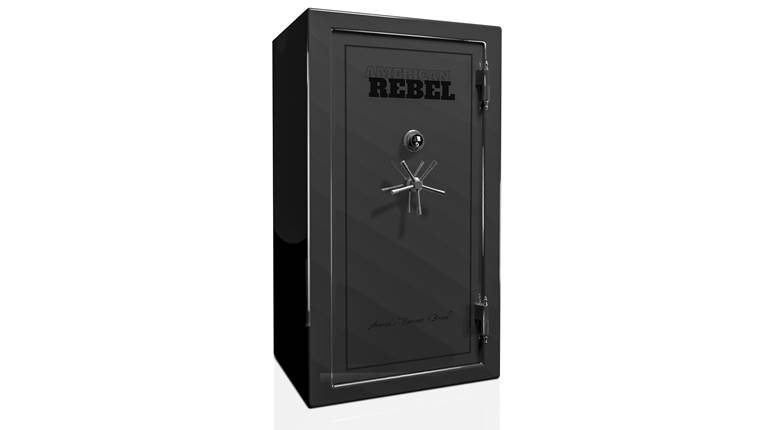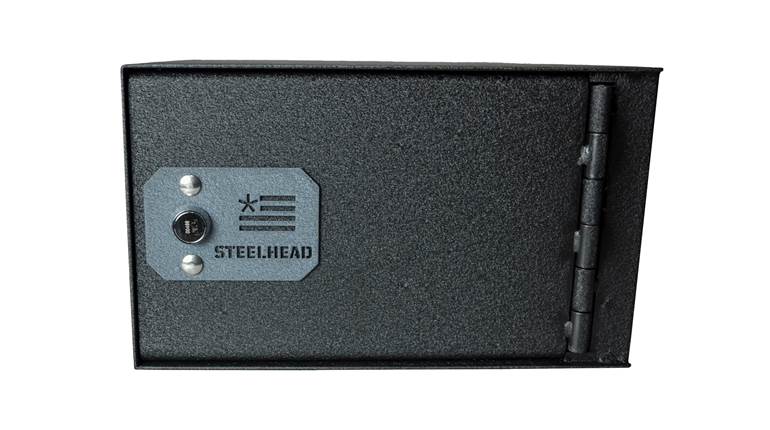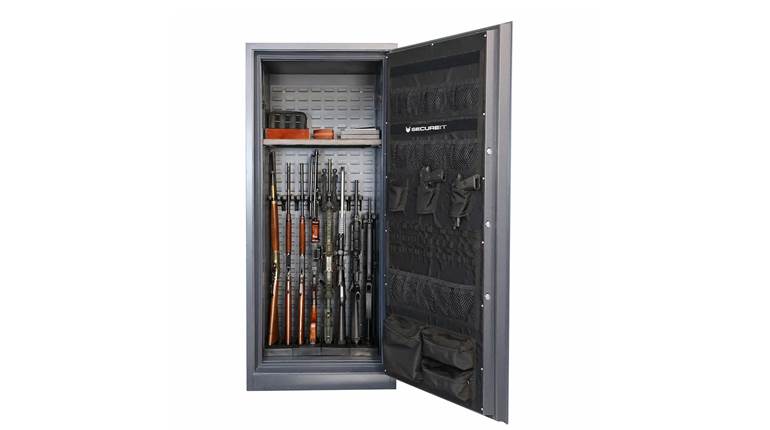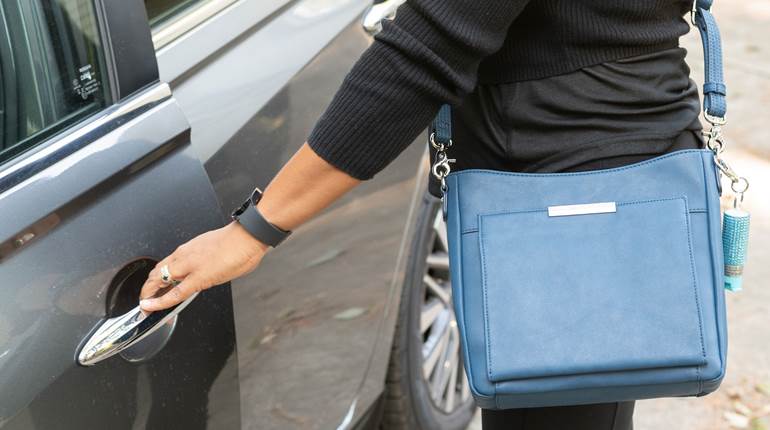
Top image courtesy SecureIt
I love DIY projects. It’s not like I could host a home-remodeling TV show, but like many women these days, I’m not exactly unhandy. “Assembly Required” does not intimidate me. At one point in my life my home was adorned with ready-to-assemble furniture purchased from a then new-to-America Swedish furniture maker which, at the time, had stores in only two U.S. locations. The company went on to singlehandedly change the perception of knockdown furniture, and today remains popular worldwide for affordable, functional home furnishings. 
So when researching gun storage options, the term “knockdown” didn’t turn me off, nor did it imply “cheaply made.” In fact, I considered it a plus. Our other home gun safe (shown right), purchased more than 10 years ago, is simply a rectangular steel box with no customization options. It was pricey and heavy, and cumbersome to get into the house, requiring delivery on heavy-duty dollies and a close friend with a pickup truck and a strong back. I don’t recall the official maximum storage capacity because our rule for some time has been “however many we can fit and still close the door.” Fire rating? If I ever knew it, I sure don’t know it now, but I suspect it’s pretty low.
We have acquired a few more guns since that initial safe purchase and have resorted to keeping some of them locked in cases and stashing them in closets or wherever they might fit. Clearly, we needed a more practical solution. We weren’t looking to store heirlooms or antique guns; we simply wanted ample storage and easy access to this handful of go-to-favorites and had but one small corner space where extra storage might work.
While comparing options that would get these guns behind locked doors without breaking the bank, I discovered the Ultralight SecureIt Agile Model 52. It checked every box: relatively affordable ($599), lightweight and unlike other options, had a customizable interior with something called CradleGrid technology—a modular system that accommodates up to six longs guns (including scoped AR-style models), a few handguns and small accessories, secured by a louvered rear panel to which the cradles are attached. And it held the promise of easy assembly—I wanted to do this myself in order to show women and men who claim they are not mechanically inclined that they didn’t have to have received an “A” grade in shop class in order to successfully assemble it.
To be clear, the Agile Model 52—like most of today’s “gun safes”—is considered a “Residential Security Container (RSC),” which is designed to keep firearms inaccessible to unauthorized individuals, or as someone stated so simply on the SecureIt website, “The SecureIt Gun Cabinet is not a fire-proof and burglar-proof vault (and neither are most gun “safes” available ... ). When you accept it for what it is and realistically assess your needs, you’ll find it is the perfect solution.”

So it’s not a “safe”? Well, no, and yes. As I dug deeper on the site, I struck gold in terms of learning the differences in gun storage options and terminology. The company offers an informative and complete timeline on the history of safes—from the earliest safes of Egyptian times, to the modern gun safe, which has its roots in the 1850’s designs of Silas Herring, who incorporated thick outer steel, plaster, and thin inner steel to create a fireproof gun storage safe. While his template continues to be used in fire safes today with improved materials, the ultimate in fire protection (double-walled steel filled with plaster or cement) is a construction method that almost all modern gun safe manufacturers (with rare exception) have abandoned. Fire ratings differ vastly from one company to the next, but few offer substantial enough rating to save firearms from total devastation. According to SecureIt, most of us have simply been lured into a false sense of security based on the perceived advantages of a heavier safe.

(SecureIt images)
I strongly recommend a visit to the highly informative SecureIt website, as it clearly conveys the company’s passion for their product and the company’s mission to truly inform the consumer. From the subtitle “Intelligent Firearm Storage” to the deep-dive “Knowledge Vault,” home to a vast array of YouTube videos and enlightening articles, the company website is almost as inspiring as the products it promotes. For me, the company’s frank assessment of gun storage and their desire to educate, not obfuscate, is refreshing—an approach I truly appreciate. 
A reading of SecureIt’s historical perspective on gun safe construction reveals changes in traditional construction that began to evolve in the 1970s. SecureIt further discusses why that bulky, heavy modern-day contraption you believe to be a fortress for your firearms, impenetrable by man or nature, might not be all that and could even be harming your guns. As explained by SecureIt, today’s gun safes are constructed from thin steel shells that get their weight from the gypsum board (drywall) and carpeting with which they are lined, both of which contain a number of reactive chemicals that can lead to corrosion. (Of note, prior to my receiving the Agile 52, SecureIt had hinted on its website its plans for something bigger: “This summer we will be releasing our “True” Safe. This is a real safe made in the tradition of the original Silas Herring fire safe design. We will be releasing details this spring.” A re-check on the site indicates that indeed they have now introduced such a model, shown here.)
An RSC—which is what most gun safes are—is defined as a container (gun cabinet) that will resist forced opening for up to five minutes by an attacker using simple, non-powered hand tools (screwdrivers, hammers that are less than 3 lbs.) and pry bars (less than 18″ long). RSC containers are not rated against any attack by power tools of any kind, or any attack lasting longer than five minutes. As said on the SecureIt website, people assume that because a container weighs 1,000 lbs., it must be secure.
This information, along with a reassessment of our “in-depth” layered residential security approach reinforced my decision that the all-steel non-corrosive Agile Model 52 would meet our immediate requirements. My order shipped quickly and, weighing 105 lbs., arrived tightly packed. I discovered that with the proper leverage, 100 lbs. is easily pushed into a garage by an average-size person. Since I was attempting to assemble the kit myself, I found it easier to open the box in the garage and then carry the pieces inside the house individually. Inside the well-conceived shipping box, plywood and cardboard shims filled the gaps between packing materials, ensuring zero movement of pieces in transit. Truth be told, it was so well-situated it took me longer to unpack the pieces than it did to assemble the entire unit. I recommend wearing work gloves and (carefully) using a sharp box cutter for this part of the job, being mindful not to slice through the plastic bubble material that protects the metal.
I won’t go into every detail of assembly—there’s an easy-to-follow manual included for that, plus great YouTube videos that walk you through the steps—but the kit comes with the six metal main panels, lock rails, and a plastic package of 8 bolts. That’s it. Impressive simplicity. Oh, and a separate box contained the saddles and the cradles in which the long guns will sit. So, simplicity and CradleGrid modularity. The best part: Other than a 10 mm socket wrench needed to tighten down several bolts, no tools are required. And unlike the famous knockdown furniture alluded to earlier, there are no pegs needed to conjoin the panels. All points of connectivity happen inside the unit (and, like interior hinges, are not accessible from the outside) and are solidly secured by a few turns of the bolts.




The container fit together with precision, though a fair amount of pressure either by hand or rubber mallet is needed to ensure the panels are properly secured into place. The only point where a second set of hands (for stability) would have been useful was while placing the door, the heaviest piece of the system—but the video demonstrates a hack for that too. Otherwise, the panels are light and easily managed by one person. The unit is only 52” tall, so even at a 5’4” I towered over it like an Amazon princess. And although the assembly process would go faster with two people rather than one, it can be accomplished relatively quickly by one. Overall this is a one-to-two-hour project, with results that suggest it took a lot more work than it did. One cautionary note: it is recommended that you secure the unit to a wall. Given the door is the heaviest panel of the container, when it is open, the possibility exists that the container may tip, particularly if it’s on carpet.
The saddles that sit on the bottom of the safe (for the buttstocks) and the cradles (for the barrels) are customizable in terms of height and distance, thanks to a rear panel full of louvers. The design will accommodate all types of rifles, including scoped ARs—which most traditional safes don’t account for. No two guns have to come in contact with each, and that alone provides a level of satisfaction not delivered with our old super-heavy model. We can probably put away our re-bluing touch-up pens … .



Please note that although SecureIt provides what can be considered a revolutionary design along with a sobering assessment on truths and myths of gun storage, there are individuals who will never be convinced that a lightweight safe is as dependable as their behemoth vaults that are in place for life. I do not discount their beliefs or their requirements, nor am I suggesting that SecureIt products act as a direct replacement for such storage options. For the skeptics, the market will always accommodate them. Consumers simply need to be fully informed on how they are constructed and the true protection they may or may not offer. Weight and volume and sheer mass do offer advantages in certain situations.
An argument can also be made for both the aesthetic quality of an heirloom vault, and the permanence such fixtures may provide in a large house. SecureIt merely provides options and freedom-of-choice to those who do not have a compelling need for such a vault or are living in circumstances where such a container is not feasible. Some may want to exercise responsible gun ownership and storage but not wish to call attention to a safe in their home. Others may be in more confined environs where portability or a lower profile is desirable. Some may want options for easier tactical access to their firearms. Others may simply lead a mobile lifestyle and relocate often due to job assignments and, therefore, want equally portable security options. Firearm storage is one component of an in-depth security strategy, with an understanding that one size does not fit all.
For our immediate purposes, I am a true convert. As promised, this gun storage system is solid, with a three-point locking system. Not only are our guns equally as secure as with the heavy drywall-and-carpet-lined safe, but we can access the guns a bit more quickly thanks to the electronic keypad, which I prefer over a combination lock. No more “turn left, right, left, pass zero, come back to zero, or wait, is it turn right, left, right pass zero twice and make sure you line up the number precisely with the line after four passes ... .” Fast access indeed eliminates this constant source of frustration. The keypad is fully programmable (instructions are included) and is powered by a 9-volt battery. The mechanism employs a lighted, low-battery-warning display, and the container is shipped with two skeleton keys that can be used as a mechanical override. 

Moreover, these safes can be situated in places that most of the heavyweights couldn’t even be considered: top floors of homes; bedroom closets; saferooms, apartments or condominiums, without compromising structural rigidity or literally being the 800-pound gorilla in the room. The pieces can be carried in individually and assembled in its permanent location as I did, or with a second pair of able hands can be relocated as an assembled (and empty) unit. SecureIt Ultralight safes come in several sizes, including a stackable model. The company also offers hidden safes, Fast Boxes and even retrofit kits for existing traditional safes. And if all that’s not enough, they offer to the public the same armory-level firearm and ammo cabinets they sell to military and law enforcement installations, all with their patent-pending CradleGrid technology.
I really like this company, and I really like their Ultralight Agile Model 52. I did, however, discover a downside to these SecureIt models: They are so affordable and easy to assemble by anybody who can turn a bolt, they serve as a tacit enabler to keep feeding an insatiable gun-buying habit. We’re going to need a bigger basement.























![Winchester Comm[94]](/media/1mleusmd/winchester-comm-94.jpg?anchor=center&mode=crop&width=770&height=430&rnd=134090756537800000&quality=60)
![Winchester Comm[94]](/media/1mleusmd/winchester-comm-94.jpg?anchor=center&mode=crop&width=150&height=150&rnd=134090756537800000&quality=60)












